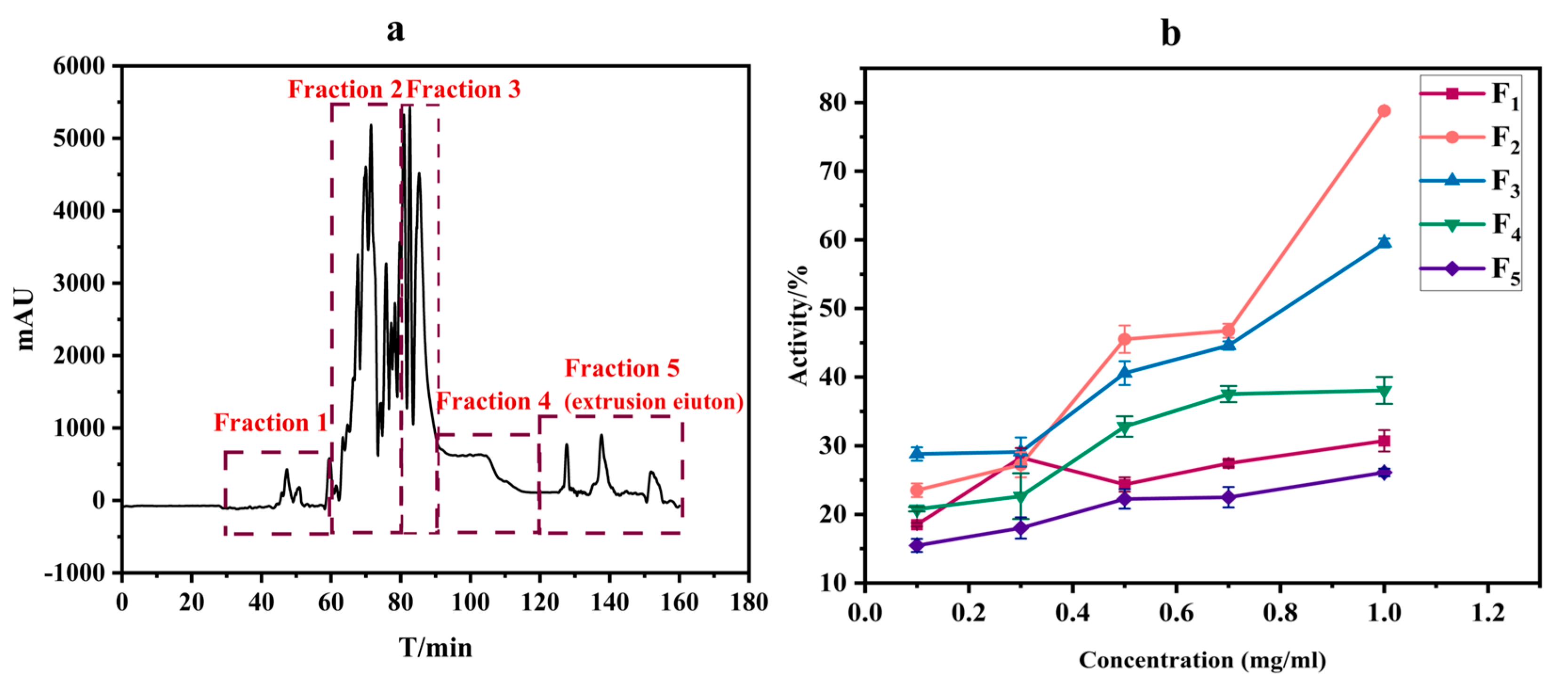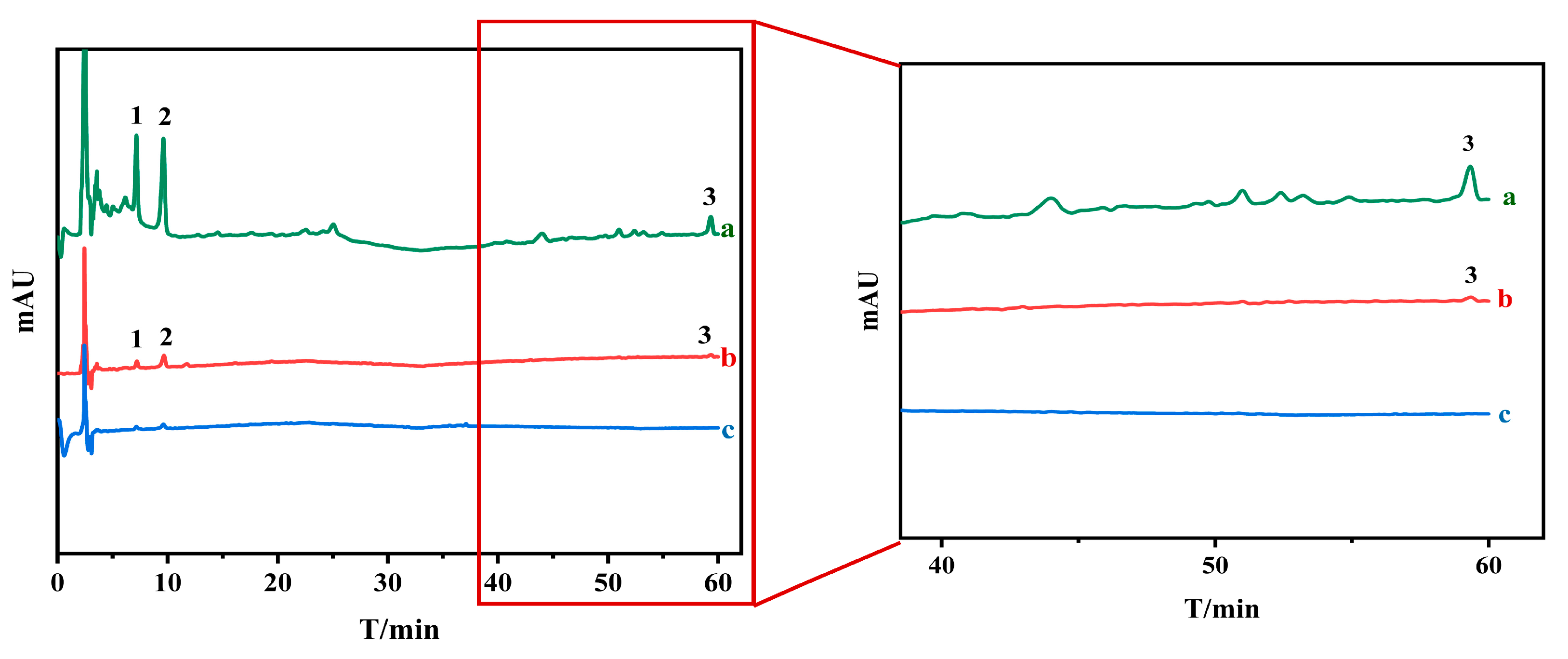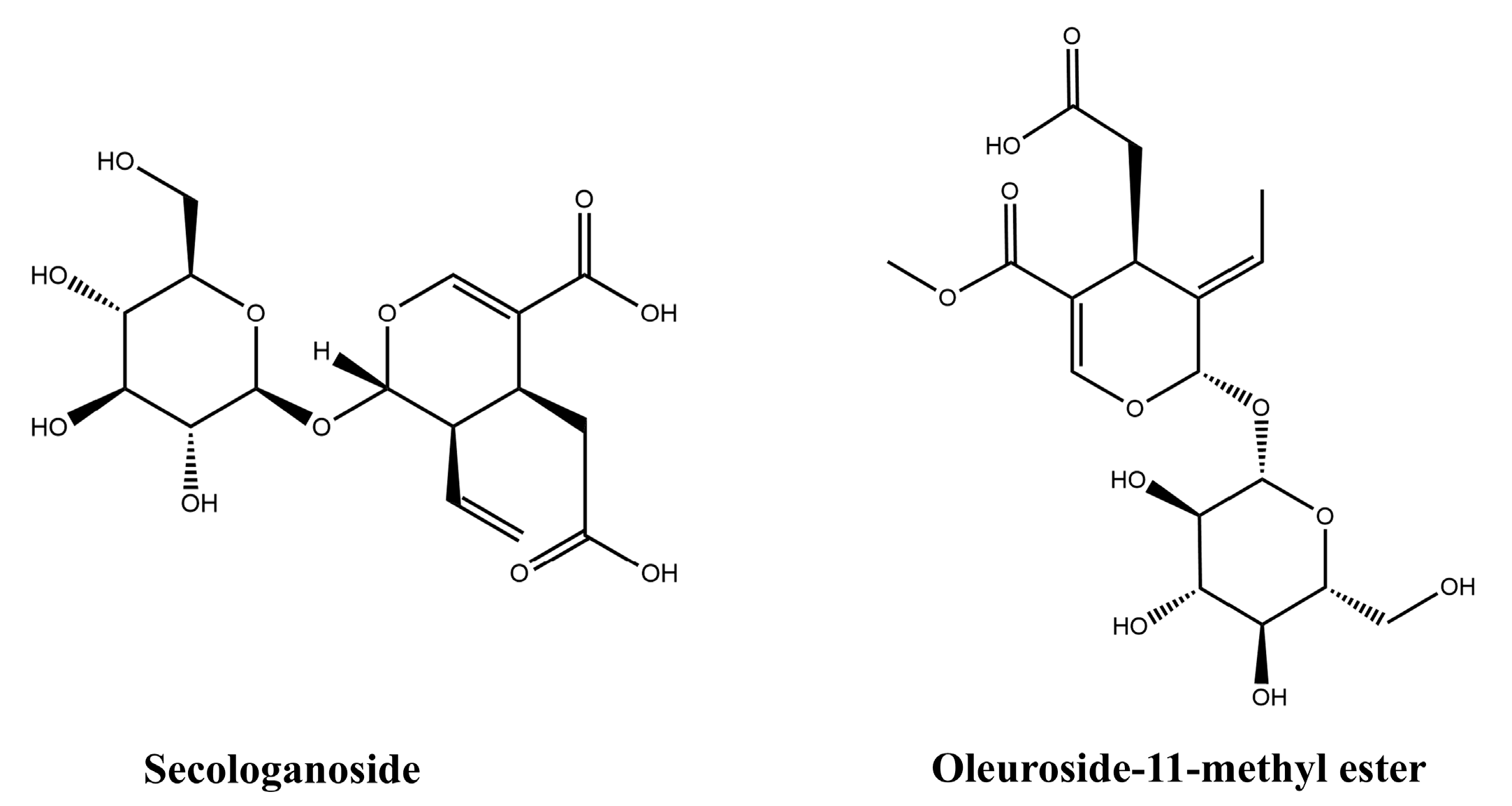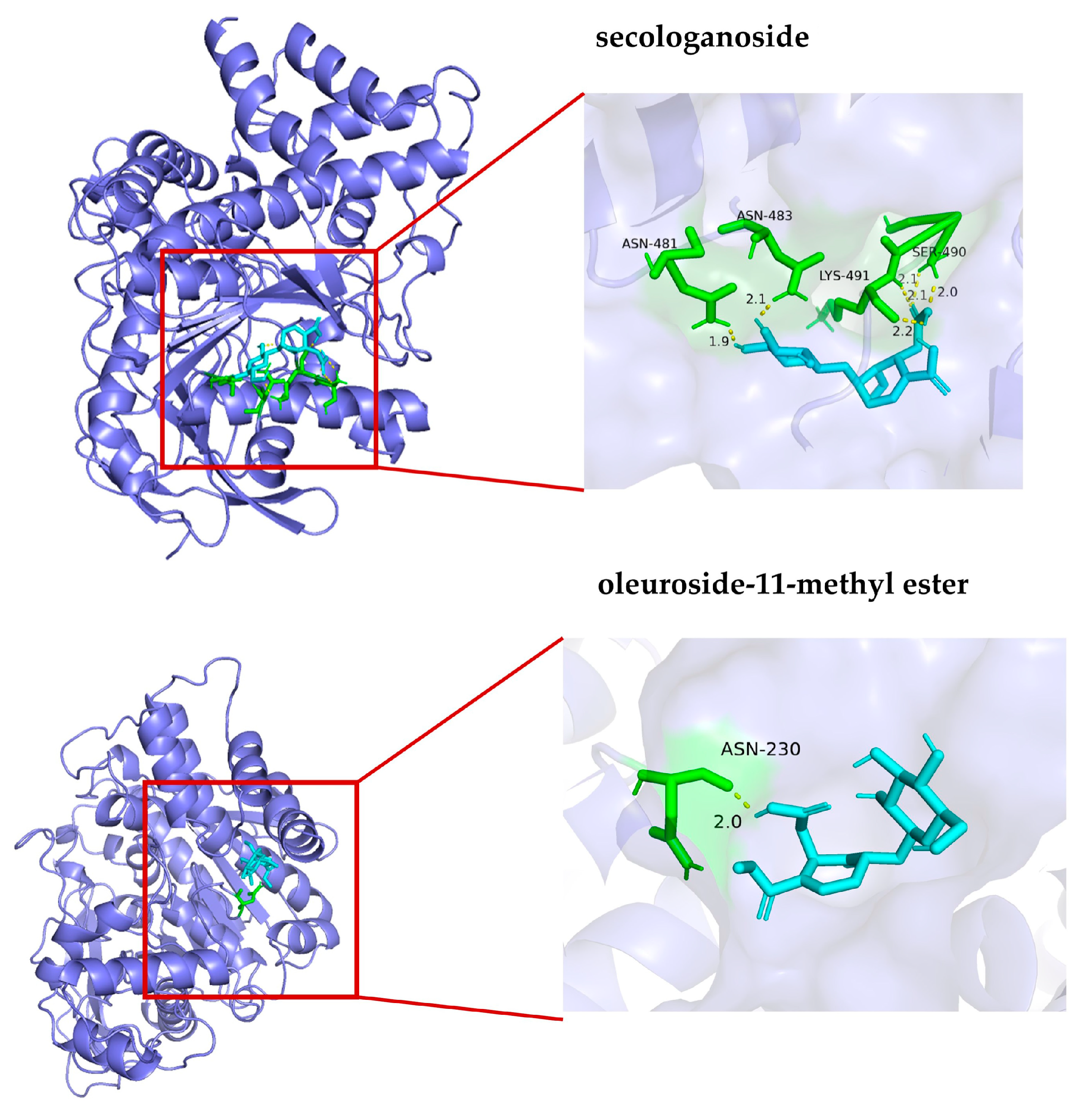Screening and Isolating Acetylcholinesterase Inhibitors from Olea europaea L. Fruit Using Ultrafiltration–Liquid Chromatography Coupled with High-Speed Counter-Current Chromatography
Abstract
1. Introduction
2. Materials and Methods
2.1. Reagents and Materials
2.2. Apparatus
2.3. Preparation of Sample Extracts
2.4. Compound Analysis with High-Performance Liquid Chromatography
2.5. Selection of Two-Phase Solvent Systems for High-Speed Counter-Current Chromatography
2.6. Separation of Crude Extracts and Active Components by High-Speed Counter-Current Chromatography
2.7. In Vitro Acetylcholinesterase Inhibition Assay to Determine the Rate of Inhibition
2.8. Screening of Acetylcholinesterase Inhibitors
2.9. Molecular Docking Analysis of the Binding Interactions Between Acetylcholinesterase and Compounds
2.10. Statistical Analysis
3. Results and Discussion
3.1. Acetylcholinesterase Inhibitory Activity of Different Fractions
3.2. Screening of Acetylcholinesterase Inhibitors by Ultrafiltration
3.3. Separation of Compounds 1 and 2 by High-Speed Counter-Current Chromatography
3.3.1. Selection of Two-Phase Solvent Systems and Calculation of Partition Coefficients
3.3.2. Optimization Results of Rotation Speed and Flow Rate
3.3.3. Optimization Results of Injection Concentration
3.4. Structural Identification of the Isolated Compounds
3.5. Inhibition of Acetylcholinesterase by Active Compounds and Molecular Docking Results
4. Conclusions
Author Contributions
Funding
Data Availability Statement
Acknowledgments
Conflicts of Interest
Abbreviations
| AChE | acetylcholinesterase |
| AD | Alzheimer’s disease |
| HSCCC | high-speed counter-current chromatography |
| UF | ultrafiltration |
References
- Cortes-Canteli, M.; Iadecola, C. Alzheimer’s disease and vascular aging: JACC focus seminar. J. Am. Coll. Cardiol. 2020, 75, 942–951. [Google Scholar] [CrossRef] [PubMed]
- Abdul Manap, A.S.; Almadodi, R.; Sultana, S.; Sebastian, M.G.; Kavani, K.S.; Lyenouq, V.E.; Shankar, A. Alzheimer’s disease: A review on the current trends of the effective diagnosis and therapeutics. Front. Aging Neurosci. 2024, 16, 1429211–1429241. [Google Scholar] [CrossRef]
- Hettiarachchi, S.D.; Zhou, Y.; Seven, E.; Lakshmana, M.K.; Kaushik, A.K.; Chand, H.S.; Leblanc, R.M. Nanoparticle-mediated approAChEs for Alzheimer’s disease pathogenesis, diagnosis, and therapeutics. J. Control. Release 2019, 314, 125–140. [Google Scholar] [CrossRef]
- Hampel, H.; Mesulam, M.M.; Cuello, A.C.; Farlow, M.R.; Giacobini, E.; Grossberg, G.T.; Khachaturian, A.S.; Vergallo, A.; Cavedo, E.; Snyder, P.J.; et al. The cholinergic system in the pathophysiology and treatment of Alzheimer’s disease. Brain 2018, 141, 1917–1933. [Google Scholar] [CrossRef]
- Chen, Z.R.; Huang, J.B.; Yang, S.L.; Hong, F.F. Role of cholinergic signaling in Alzheimer’s Disease. Molecules 2022, 27, 1816. [Google Scholar] [CrossRef] [PubMed]
- Ozsahin, I.; Onakpojeruo, E.P.; Uzun, B.; Ozsahin, D.U.; Butler, T.A. Comparative evaluation of FDA-approved drugs for managing the symptoms of AD. Alzheimer’s Dement. 2023, 19, e075669–e075679. [Google Scholar] [CrossRef]
- Li, X.; Li, W.; Tian, P.; Tan, T. Delineating biosynthesis of Huperzine A, A plant-derived medicine for the treatment of Alzheimer’s disease. Biotechnol. Adv. 2022, 60, 108026–108037. [Google Scholar] [CrossRef] [PubMed]
- Hutchings, K.R.; Hutchings, B.K.; Ratnakaran, B.; Kablinger, A.S. Donepezil-induced psychosis: A cautionary report of a rare adverse reaction. Eur. Psychiatry 2023, 66, S357–S358. [Google Scholar] [CrossRef]
- Yang, M.; Zhang, X.; Qiao, O.; Ji, H.; Zhang, Y.; Han, X.; Wang, W.; Li, X.; Wang, J.; Guo, L.; et al. Rosmarinic acid potentiates and detoxifies tacrine in combination for Alzheimer’s high-performance liquid chromatography disease. Phytomedicine 2023, 109, 154600–154612. [Google Scholar] [CrossRef]
- Nam, Y.; Shin, S.J.; Park, Y.H.; Kim, M.J.; Jeon, S.G.; Lee, H.; Choi, Y.; Kim, T.J.; Shin, S.M.; Kim, J.J.; et al. Platycodon grandiflorum root protects against Aβ-Induced cognitive dysfunction and pathology in female models of Alzheimer’s Disease. Antioxidants 2021, 10, 207. [Google Scholar] [CrossRef]
- Refaey, M.S.; Abdelhamid, R.A.; Elimam, H.; Elshaier, Y.A.M.M.; Ali, A.A.; Orabi, M.A. A bioactive constituent from thunbergia erecta as potential anticholinesterase and anti-ageing agents: Experimental and in silico studies. Bioorg. Chem. 2021, 108, 104643–104653. [Google Scholar] [CrossRef]
- Li, J.G.; Mutreja, Y.; Servili, M.; Leone, A.; Praticò, D. The anti-neuroinflammatory effect of extra-virgin olive oil in the triple transgenic mouse model of Alzheimer’s Disease. JAD 2024, 100, 119–126. [Google Scholar] [CrossRef]
- Guo, J.; Lin, H.; Wang, J.; Lin, Y.; Zhang, T.; Jiang, Z. Recent advances in bio-affinity chromatography for screening bioactive compounds from natural products. JPBA 2019, 165, 182–197. [Google Scholar] [CrossRef]
- Cieśla, Ł.; Moaddel, R. Comparison of analytical techniques for the identification of bioactive compounds from natural products. Nat. Prod. Rep. 2016, 33, 1131–1145. [Google Scholar] [CrossRef] [PubMed]
- Hou, X. Recent advances in screening active components from natural products based on bioaffinity techniques. Acta Pharm. Sin. B 2020, 10, 1800–1813. [Google Scholar] [CrossRef]
- Fu, Y.; Luo, J.; Qin, J.; Yang, M. Screening techniques for the identification of bioactive compounds in natural products. J. Pharm. Biomed. Anal. 2019, 168, 189–200. [Google Scholar] [CrossRef] [PubMed]
- Kusuma, I.Y.; Habibie, H.; Bahar Muh, A.; Budán, F.; Csupor, D. Anticancer effects of secoiridoids—A scoping review of the molecular mechanisms behind the chemopreventive effects of the olive tree components oleocanthal, oleacein, and oleuropein. Nutrients 2024, 16, 2755. [Google Scholar] [CrossRef]
- Angeloni, C.; Malaguti, M.; Barbalace, M.; Hrelia, S. Bioactivity of olive oil phenols in neuroprotection. Int. J. Mol. Sci. 2017, 18, 2230. [Google Scholar] [CrossRef]
- Senol, F.S.; Ankli, A.; Reich, E.; Orhan, I.E. HPTLC fingerprinting and cholinesterase inhibitory and metal-chelating capacity of various citrus cultivars and Olea europaea. Food Technol. Biotechnol. 2016, 54, 275–281. [Google Scholar] [CrossRef]
- Omar, S.H.; Scott, C.J.; Hamlin, A.S.; Obied, H.K. Biophenols: Enzymes (β-secretase, cholinesterases, histone deacetylase and tyrosinase) inhibitors from olive (Olea europaea L.). Fitoterapia 2018, 128, 118–129. [Google Scholar] [CrossRef]
- Li, Y.J.; He, F.Q.; Zhao, H.H.; Li, Y.; Chen, J. Screening and identification of acetylcholinesterase inhibitors from Terminalia chebula fruits by immobilized enzyme on cellulose filter paper coupled with ultra-performance liquid chromatography-quadrupole time-of-flight spectrometry and molecular docking. J. Chromatogr. A 2022, 1663, 462784–462798. [Google Scholar] [CrossRef]
- Liang, J.; Zhang, Y.; Liu, C.; Li, S.; Li, R.; Zhang, Y.; Chen, M.; Sun, R. High-speed countercurrent chromatography isolation of active components from Evodia rutaecarpa and affinity ultrafiltration Screening for their acetylcholinesterase inhibitor activity. J. Sep. Sci. 2024, 47, e70002–e70012. [Google Scholar] [CrossRef]
- Trott, O.; Olson, A.J. AutoDock Vina: Improving the speed and accuracy of docking with a new scoring function, efficient optimization, and multithreading. J. Comput. Chem. 2010, 31, 455–461. [Google Scholar] [CrossRef] [PubMed]
- Ito, Y. Golden rules and pitfalls in selecting optimum conditions for high-speed counter-current chromatography. J. Chromatogr. A 2005, 1065, 145–168. [Google Scholar] [CrossRef] [PubMed]
- Chen, T.; Wang, P.; Wang, N.; Sun, C.; Yang, X.; Li, H.; Zhou, G.; Li, Y. Separation of three polar compounds from rheum tanguticum by high-speed countercurrent chromatography with an ethyl acetate/glacial acetic acid/water system. J. Sep. Sci. 2018, 41, 1775–1780. [Google Scholar] [CrossRef]
- Bailleul, F.; Leveau, A.M.; Durand, M. Nouvel iridoide des fruits de lonicera alpigena. J. Nat. Prod. 1981, 44, 573–575. [Google Scholar] [CrossRef]
- Shen, Y.C.; Lin, S.L.; Chein, C.C. Jaspolyside, a secoiridoid glycoside from Jasminum polyanthum. Phytochemistry 1996, 42, 1629–1631. [Google Scholar] [CrossRef]





| Solvent System (v/v) | K1 | K2 |
|---|---|---|
| ethyl acetate/n-butanol/water (1:4:5) | - | 0.23 |
| ethyl acetate/n-butanol/water (0.5:5:5) | 0.29 | 0.87 |
| ethyl acetate/n-butanol/water (0.5:4:5) | - | 0.27 |
| n-butanol/acetic acid/water (2:0.05:2) | 0.62 | 1.52 |
| n-butanol/acetic acid/water (2:0.02:2) | 0.8 | 1.76 |
| n-butanol/acetic acid/water (2:0.15:2) | 0.63 | 1.45 |
| Flow Rate | Rotation Speed | Sf | Rotation Speed | Flow Rate | Sf |
|---|---|---|---|---|---|
| 2 mL/min | 850 rpm | 0.49 | 900 rpm | 1.5 mL/min | 0.56 |
| 900 rpm | 0.55 | 2 mL/min | 0.55 | ||
| 950 rpm | 0.56 | 2.5 mL/min | 0.53 |
| Compounds | Affinity (kcal/mol) | IC50 Value (mM) | Residues in Close Contact | Hydrogen Bond (Å) |
|---|---|---|---|---|
| secologanoside | −6.21 | 0.76 ± 0.04 | ASN481, SER490, LYS491, ASN483 | ASN481 (1.9), SER490 (2.1, 2.0), LYS491 (2.2, 2.1), ASN483 (2.1) |
| oleuroside-11-methyl ester | −4.52 | 1.08 ± 0.05 | ASN230 | ASN230 (2.0) |
Disclaimer/Publisher’s Note: The statements, opinions and data contained in all publications are solely those of the individual author(s) and contributor(s) and not of MDPI and/or the editor(s). MDPI and/or the editor(s) disclaim responsibility for any injury to people or property resulting from any ideas, methods, instructions or products referred to in the content. |
© 2025 by the authors. Licensee MDPI, Basel, Switzerland. This article is an open access article distributed under the terms and conditions of the Creative Commons Attribution (CC BY) license (https://creativecommons.org/licenses/by/4.0/).
Share and Cite
Wang, X.; Zhang, Y.; Muhire, J.; Di, D.; Huang, X.; Pei, D. Screening and Isolating Acetylcholinesterase Inhibitors from Olea europaea L. Fruit Using Ultrafiltration–Liquid Chromatography Coupled with High-Speed Counter-Current Chromatography. Separations 2025, 12, 96. https://doi.org/10.3390/separations12040096
Wang X, Zhang Y, Muhire J, Di D, Huang X, Pei D. Screening and Isolating Acetylcholinesterase Inhibitors from Olea europaea L. Fruit Using Ultrafiltration–Liquid Chromatography Coupled with High-Speed Counter-Current Chromatography. Separations. 2025; 12(4):96. https://doi.org/10.3390/separations12040096
Chicago/Turabian StyleWang, Xingcui, Yingshan Zhang, Jules Muhire, Duolong Di, Xinyi Huang, and Dong Pei. 2025. "Screening and Isolating Acetylcholinesterase Inhibitors from Olea europaea L. Fruit Using Ultrafiltration–Liquid Chromatography Coupled with High-Speed Counter-Current Chromatography" Separations 12, no. 4: 96. https://doi.org/10.3390/separations12040096
APA StyleWang, X., Zhang, Y., Muhire, J., Di, D., Huang, X., & Pei, D. (2025). Screening and Isolating Acetylcholinesterase Inhibitors from Olea europaea L. Fruit Using Ultrafiltration–Liquid Chromatography Coupled with High-Speed Counter-Current Chromatography. Separations, 12(4), 96. https://doi.org/10.3390/separations12040096









